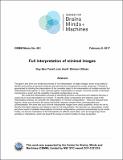Full interpretation of minimal images
Author(s)
Ben-Yosef, Guy; Assif, Liav; Ullman, Shimon
DownloadCBMM-Memo-061.pdf (4.641Mb)
Terms of use
Metadata
Show full item recordAbstract
The goal in this work is to model the process of ‘full interpretation’ of object images, which is the ability to identify and localize all semantic features and parts that are recognized by human observers. The task is approached by dividing the interpretation of the complete object to the interpretation of multiple reduced but interpretable local regions. In such reduced regions, interpretation is simpler, since the number of semantic components is small, and the variability of possible configurations is low.
We model the interpretation process by identifying primitive components and relations that play a useful role in local interpretation by humans. To identify useful components and relations used in the interpretation process, we consider the interpretation of ‘minimal configurations’: these are reduced local regions, which are minimal in the sense that further reduction renders them unrecognizable and uninterpretable. We show that such minimal interpretable images have useful properties, which we use to identify informative features and relations used for full interpretation. We describe our interpretation model, and show results of detailed interpretations of minimal configurations, produced automatically by the model. Finally, we discuss implications of full interpretation to difficult visual tasks, such as recognizing human activities or interactions, which are beyond the scope of current models of visual recognition.
Date issued
2017-02-08Publisher
Center for Brains, Minds and Machines (CBMM)
Series/Report no.
CBMM Memo Series;061
Keywords
Image interpretation, Visual object recognition, Parts and relations
Collections
The following license files are associated with this item: